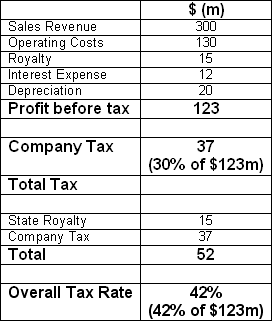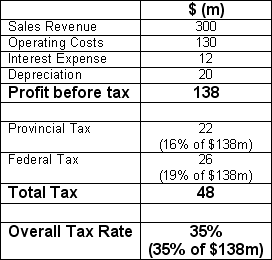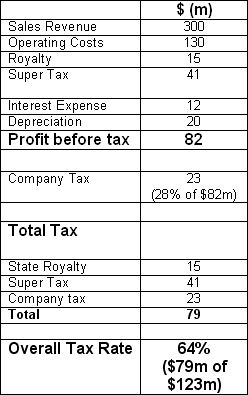For many investors in international precious metals companies, the Australian government’s recent bomb shell of a super profits tax on mining companies may seem somewhat irrelevant. This will especially be the case if you do not invest in companies with mining assets in Australia. However, the implications of this tax if passed may be broader. Especially given Australia’s standing in the international mining community. If lesser developed countries see Australia, a seemingly advanced economy, employing such an opportunistic tax regime, they may see this as an acceptable precedent to follow suit. Australian treasurer Wayne Swan on the announcement of the tax came out and brazenly dismissed speculation that this new tax would negatively impact investment in Australian mining projects.
I want to demonstrate the impact of this proposed tax. I will compare the proposed taxation of a project here in Australia with that of one of the highest taxed provinces in Canada, Nova Scotia. I personally invest in mining companies listed both here in Australia and on the North American exchanges. Believe me when I say the tax rate a government imposes on a mining company’s projects matters a great deal when it comes to making investment decisions. I will demonstrate this as well as giving some insight as to why Australia’s mining sector has been hit so hard since the announcement of this tax, recent market jitters aside.
Case study
Let’s take a simple gold mining company called Gold Miner Ltd which is highly profitable. Gold Miner in its first year of production from its sole project generated $300 million from the sale of gold at an operating cost of just $130 million (excluding state royalties of 5 per cent of gross sales). The company has Property Plant and Equipment which consists of $200 million in pre-production capital expenditure. Gold Miner also has borrowings of $100 million with interest payable at 12 per cent per annum. The life of the mine is 10 years. The company’s details are summarised below:
Advertisement
Gold Miner Ltd Details
Project:
Mine Life: 10 years
State Royalty: 5% of gross sales
Pre-Production Capital: $200m
Borrowings: $100m
Sales Revenue: $300m
Operating Costs: $130m
Interest Expense: $12m (12% of $100m in borrowings)
Royalty: $15m (5% of $300m in sales)
Depreciation: $20m (10% of $200m pre-production capital)
Example 1: Australia’s Existing Tax Structure:

Example 2: Same project based in Nova Scotia, Canada:
In Canada, the company will pay a provincial tax instead of a state royalty. For simplicity we will exclude any native title related royalties (paid in both Australia and Canada). We will also assume the application of similar depreciation rates for tax purposes even though Canadian companies typically enjoy more flexibility with accelerated depreciation options.
Advertisement

Example 3: Australia’s new proposed tax structure:
Part 1 Super Tax Calculation:

Part 2 Company Tax Calculation:

Looking at the above example you may be wondering how this Tax on Super profits got its name and whether this tax is applicable to just highly profitable mining companies. The government, in its infinite wisdom, has decided a super profit equates to anything over and above the risk free rate of return on Australian long term bonds (presently 5.7 per cent). Note the capital allowance in our example above which allows a deduction of 5.7 per cent of the investment in the gold mine ($200 million) or $11 million. Let me put this miserly rate of return into context for you.
Having spent the best part of the last 10 years of my working life focused on investing in gold mining companies, you learn that this business is very risky (very often the hard way!). I have witnessed what seems like a countless number of mining companies fail to realise their feasibility study predictions due to any number of unforeseen circumstances. To arrive at a 5.7 per cent risk free rate of return as a reasonable profit to make on a mining venture fails miserably to adequately compensate for this risk. Mining companies need to be rewarded for the gamble they take on developing a project, otherwise what would be the point.
They face risks associated with fluctuating metal prices, geological anomalies, weather related events not to mention human error. If a mining company is not making at least a 5.7 per cent return on its investment before financing costs, I think it is pretty safe to assume the company is in some trouble.
I can assure you that when a bank lends money to a mining company, it takes these risks into account. If we use our example above, you can see that the government’s deductible capital allowance of $11 million fails to even cover the company’s financing costs of $12 million, which are conveniently disallowed as a deduction in calculating the pre-super tax profit. In other words, if the government considers $11 million to be a reasonable rate of return on Gold Mining Ltd’s assets before financing costs, they would consider a loss making position for the company reasonable for the purposes of calculating this super tax. Regardless of the repayment of the debt over time, this is laughable and demonstrates the ignorance involved in formulating this tax. Let us now consider the effect this tax might have on the valuation of mining companies with projects in Australia.
Gold Miner Ltd Profit after Tax under each scenario:
Example 1: $86m (Australia’s existing tax structure)
Example 2: $90m (Canada’s highest taxed province Nova Scotia)
Example 3: $59m (Australia’s proposed mining tax on super profits)
Assuming Gold Miner Ltd is valued on the basis of on an undiscounted after tax earnings multiple of 9 (reflecting the remaining life of the mine) you could get a very rough back of the envelope valuation of the following:
Example 1: $774m
Example 2: $810m
Example 3: $531m
Note under Australia’s existing taxation system and an example of Canada’s highest taxed Nova Scotia province, the valuation results are very similar give or take less than 5 per cent. Under the third scenario of Australia’s proposed taxation system we see the valuation is substantially less. Under Example 3, the company is worth close to 31 per cent less than under Australia’s existing taxation system (Example 1). This is a substantial difference. Make no mistake, if this proposed tax is passed in its present form, there will be serious implications for the valuation of mining companies with primarily Australian based projects. Something we have already seen reflected in the markets on just the announcement of the tax a few weeks ago.
As an investor who wants to maximise my profit making ability from investing in gold mining companies, it is times like these I am relieved to have an international trading account set up in Canada. This gives me the flexibility to focus my attention overseas in the event the tax is passed. Even the threat of Labor’s super tax muddies the waters for companies with development stage projects as well as producing projects. “No impact on investment in Australian mining assets” our treasurer Wayne Swan predicts. I think you would agree looking at the above demonstration that this is the typical unsubstantiated rubbish our politicians feed us on a regular basis.
The investment market is no different from any other market. There are competitors (a concept government doesn’t understand). Although Australia is blessed with natural resources, it is not the only country with commodities on offer. Unlike the public sector, mining companies live in the real world and have a mandate to maximise shareholder wealth when choosing projects to pursue and develop. Their cost of capital is also at real world rates, substantially higher than the risk free rate of return on long term bonds!
Like the mining companies we invest in, our goal as investors is to maximise the rate of return on our investments. If you, like many Australians, are limiting yourself to investing in just Australian precious metals companies, I urge you to start considering alternative options. While there are still many great companies listed in Australia with international projects which won’t be affected by the new tax, you are limiting your opportunities by not considering the North American exchanges. North America offers a much wider selection of established gold and silver mining companies to invest in. Canada, unlike Australia, are reducing their corporate tax rate for mining companies with the combined rate expected to average just 25 per cent by 2012.
Canada’s finance minister Jim Flaherty was recently quoted as saying: “The easiest thing for a politician to do is raise taxes, which immediately increases revenues, but limits growth.” The fundamental difference between the two governments is that Canada’s government understands the big picture.
Jim Flaherty goes on to say that the continued decline in corporate taxes in Canada was a “great attraction for investment” and that Australia’s proposed new tax on its resources industry could be a huge competitive advantage for Canada. I hope this article has effectively demonstrated that the proposed mining tax on super profits is material enough to significantly influence the investment decisions companies and investors will make going forward.
DISCLAIMER: This publication has been prepared from a wide variety of sources which the editor, to the best of his knowledge and belief, considers accurate. The editor does not warrant the accuracy of the information and forecasts contained in this publication. This information is provided for educational purposes and nothing written should be construed as a solicitation to buy and sell securities. First published in The Global Speculator on May 17, 2010.